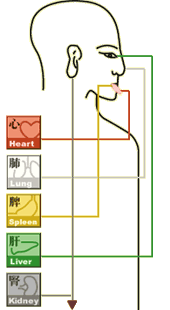How Chinese Medicine Understands Headache Disorders
 Head orifices are the openings
Head orifices are the openingson the head such as the eyes,
ears, nose and mouth. Traditional Chinese medicine (TCM) regards the head as "the confluence of yang" and "the dwelling of lucid yang," which mean the head is closely connected with other parts of the body, and all the organs are responsible for nourishing it. Moreover, TCM holds that the brain is the sea of marrow, which is derived from kidney essence and nourished by food nutrients. The head connects with the internal organs through the meridians and collaterals; it also has orifices to communicate with the external directly. When external or internal factors impede the flow of meridians, disturb nutrient supply to the head, and block the head orifices, headaches will occur. Since there are many triggers or causes for headaches, the frequency and severity vary considerably between individuals. It may be a challenge to diagnose and treat headaches sometimes. Clinically, TCM physicians rely on specific headache details to analyze the pathological changes inside the body; the information help them find the underlying disharmony patterns and provide guideline for the treatments. Below are TCM views on some headache disorders and the treatment principles.


